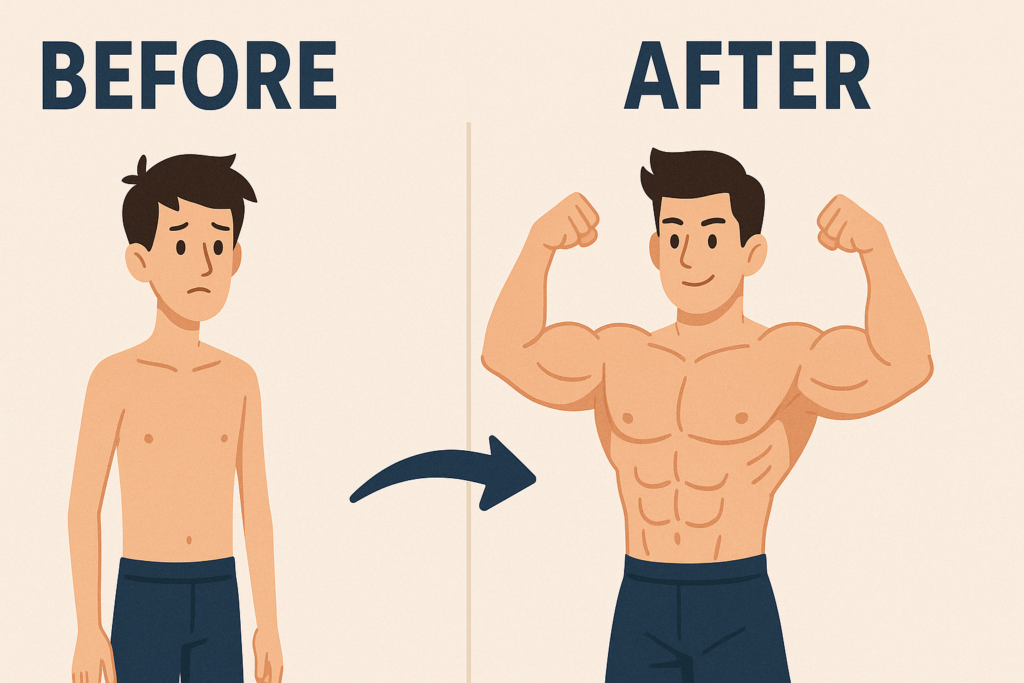what you’ll learn about lean bulking in this post
Thinking about building muscle but worried about gaining fat? You’re not alone.
Many people start bulking only to end up feeling bloated, fluffy, and frustrated. But it doesn’t have to be that way — lean bulking is a smarter, more sustainable approach to gaining size while keeping your physique sharp.
👉 In this post, you’ll learn:
- What lean bulking actually is (and how it differs from dirty bulking)
- How to eat for lean gains — calories, macros, and food strategy
- How to Train for Lean Bulking: The Core Methodology
- Lean Bulking Plans: Build the Right Plan for you!
By the end of this article, you’ll walk away with a clear roadmap and a ready-to-use plan — no guesswork, no fluff.
What lean bulking actually is: how it differs from dirty bulking
Dirty bulking = mass + fat
Lean bulking = gradual, clean gains
When most people hear “bulking,” they imagine loading up on calories, gaining size fast — and ending up with a belly to match their biceps. That’s dirty bulking.
Lean bulking, on the other hand, is a more calculated, sustainable approach. You still eat in a calorie surplus to build muscle, but it’s controlled — typically just 200–300 calories above maintenance. You pair that with structured resistance training to ensure most of your gains come from lean tissue, not fat.
| Dirty Bulk | Lean Bulk | |
| Calories | Large surplus (+500-1000) | Smale surplus (+200-300) |
| Weight Gain | Fast, mostly uncontrolled | Slow, mostly muscle |
| Aesthetic | puffy, bulkier | Defined, stronger look |
| Who it’s for | Pro bodybuilders, offseason | Lifters who care about aesthetic |
How to Eat for Lean Gains
To build muscle without gaining unnecessary fat, your diet needs to be strategic, not excessive. That’s the essence of lean bulking.
1. Start with a Small Calorie Surplus
Instead of stuffing yourself, aim for a 200–300 calorie surplus per day above your maintenance level. This is enough to support muscle growth while minimizing fat gain.
| Not sure where your maintenance is? Multiply your body weight (in lbs) by 15–16 for a rough estimate.
2. Prioritize the Right Macros
Here’s a basic macro breakdown for lean bulking:
- Protein: 0.8–1.2g per lb of bodyweight
Supports muscle repair and growth. - Carbs: 2–2.5g per lb
Fuels training intensity and helps with recovery. - Fats: 0.3–0.4g per lb
Supports hormones and joint health — don’t go too low!
|💡 Tip: Focus on consistency — a clean surplus over time beats extreme spikes and crashes.
3. Choose Quality Foods
| ✅ Eat More of | ❌ Limit |
| Lean Meats (chicken, beef, fish) | Sugary processed snacks |
| Egg, Greek yogurt | Deep-fried foods |
| Rice, oats, potatoes | Excess sauces/oils |
| Nuts, olive oil | Alcohol & liquid calories |
| veggies & fruits | Fast food “bulking meals” |
| you don’t have to be perfect – but 80% clean foods, 20% flexibility is a solid rule
How to Train for Lean Bulking: The Core Methodology
Before we dive into specific lean bulking plans, it’s important to understand the basic training principles that apply to everyone looking to gain muscle without unnecessary fat.
Lean bulking relies on hypertrophy-focused resistance training — typically using moderate weights (65–75% of your 1RM), higher rep ranges (8–15), and short rest periods (30–90 seconds). The key is progressive overload: gradually increasing training demands through more reps, weight, sets, or advanced set types like drop sets and failure sets. Most effective plans follow a split routine (like push-pull-legs or upper/lower) that balances training volume with recovery.
|Try to use Jefit’s Routine Builder, you can set your weekly frequency, pick priority muscle groups, and fine-tune each workout — including rest time and set structure — to match your specific needs.
Get Your Lean Bulking Plan — Designed to Match Your Goals
weekly layout:
| Day | Focus |
| Mon | Upper A – Push Focus |
| Tue | Lower A – Strength |
| Thur | Upper B – Pull Focus |
| Fri | Lower B – Volume Glutes |
The routine outlined above serves as a structural overview. A complete version of this 4-day lean bulking plan — including set types, reps, rest intervals, and muscle group focus — is here
you can open it directly via the link, review each session in detail, and adjust based on your own training needs.
🔗 View the full plan in Jefit Routine builder ->
Customize Your Lean Bulk Plan with Jefit’s Routine Builder
Unlike static PDF workout templates, the Jefit Routine Builder lets you fully control each detail of your training:
- 💪 Edit every set: You can adjust reps, weight, and even the type of set (normal, drop set, failure set, etc.)
- ⏱ Set rest intervals between sets to match your training intensity and goal
- 🔁 Use auto rest timers to stay consistent and avoid over resting
- 📲 Sync the plan instantly to your phone — build on desktop, follow on mobile
✅ Whether you want to experiment with RIR-based hypertrophy or set up a pyramid-style structure, Jefit lets you build and modify everything — no spreadsheets needed.
- Introducing BodyMap: A Smarter Way to Visualize Your Training - November 3, 2025
- Jefit Widgets Are Live on IOS - October 14, 2025
- New:Track Heart Rate, Calories in Real Time with JEFIT Apple Watch - October 7, 2025
